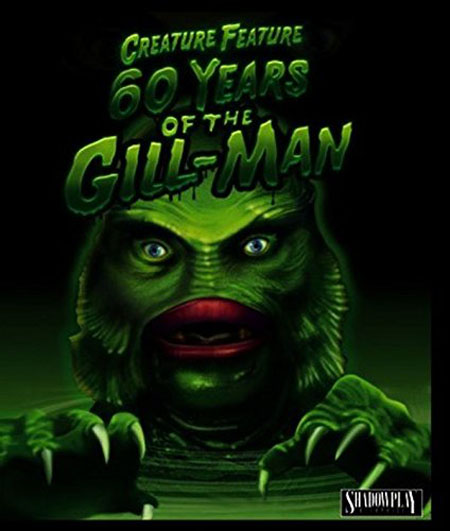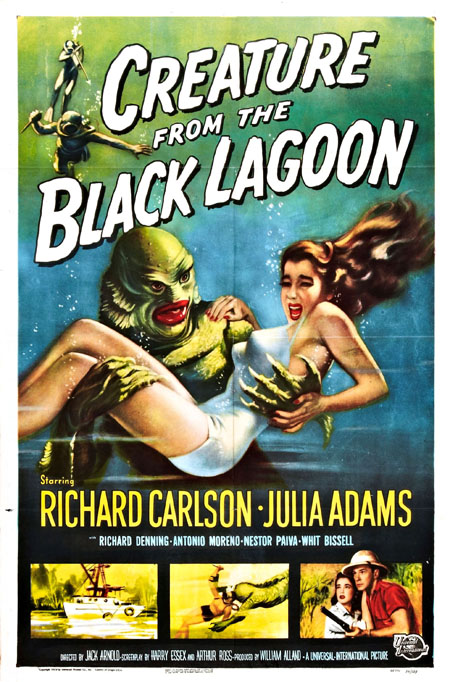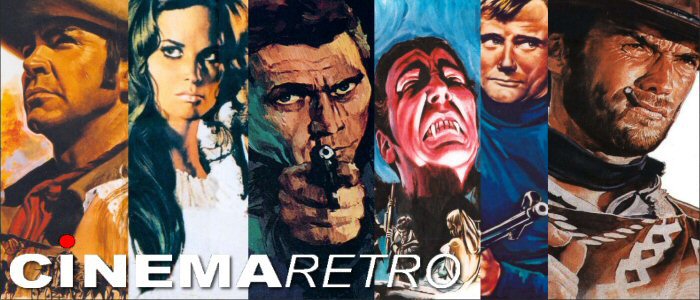
BY HANK REINEKE
Creature
Feature: 60 Years of the Gill Man is, essentially, a
seventy-four minute valentine to Universal-International’s The Creature from the Black Lagoon. Beginning with their lavish staging of The Phantom of the Opera (1925), Universal was Hollywood’s
uncontested House of Horrors, the motion-picture industry’s preeminent fright
factory throughout the 1930s and 1940s. Their films brought to the screen the
most enduring visages of this golden age of horror. The studio made familiar faces – and
occasional bankable stars - of their contract players and talent for hire: Boris Karloff, Bela Lugosi, Claude Rains, George
Zucco, Basil Rathbone, Lionel Atwill, John Carradine, Evelyn Ankers, Maria
Ouspenskaya, and Lon Chaney Jr.
But the trademark old castles and foggy moor scenarios
on which the old Universal films were staged were largely gone by the early
1950s. In the years prior to England’s
Hammer Studios breathing colorful - and sexy - new life into the gothic-horror
genre, the creaking-door chillers of times past had been supplanted by new
atomic-age monsters and belligerent visitors from the farthest reaches of
outer-space. Universal, re-christened as
Universal-International following a company merger in 1946, proved adaptable to
the change. The studio would produce
nearly as many classics during the silver-age of 1950’s science-fiction as it
had with its gothic-horrors.
The most successful and iconic of all the Universal
monster-movies of the 1950s was, without rival, Jack Arnold’s The Creature from the Black Lagoon
(1954). Arnold and producer William
Alland had worked previously – and successfully - on the sci-fi classic It Came from Outer Space (1953), so the
studio wasn’t being incautious when they invested $600,000 of those earnings on
a second collaboration. Photographed in
glorious black-and-white, principal shooting was scheduled for the Universal
back-lot and on the freshwater bayous of Wakulla Springs outside Tallahassee, Florida.
The Creature from the Black Lagoon
was one the biggest box-office successes of 1954 bringing in an estimated three
million dollars on its first year of release.
The popularity of the film spawned two successful sequels,
Revenge of the Creature (1955) and The Creature Walks Among Us (1956). The original film was such a phenomenon that
its pop-culture status was unusually acknowledged - and cross-promoted - by
rival studio 2oth Century-Fox. In a
famous sequence from Billy Wilder’s The
Seven Year Itch (1955), Marilyn Monroe and Tom Ewell are seen walking out
of a theater screening of The Creature
from the Black Lagoon. As the two
stroll along curbside, Monroe’s dress billows upward from a rush of air through
the sidewalk’s subway grate.
In a supplement from Creature Feature: 60 Years of the Gill Man, producer-writer Sam
Borowski offers that his affectionate documentary on the history and legacy of
the Gill-man was a labor-of-love. Borowski
recalls first meeting documentarian Matt Crick in lower Manhattan on what was otherwise
a solemn occasion. Both men were in
attendance at a memorial processional following the attack on the World Trade
Center, September 11, 2001. Having long
pondered a tribute to this much-loved monster-series, the producer admits it
was only after Crick signed on that the laborious process of pulling together the
bits of fragmented memories, ephemera and vintage celluloid would commence.
They had a rough-cut of the film assembled as early as
2004, and it was rumored that their documentary would be featured as a
supplement on Universal’s The Creature
from the Black Lagoon “Legacy Collection†release of 2004. For whatever reason, that didn’t happen; even
though the back cover of that DVD set oddly features an attribution credited to
the film (then sub-titled “50 years of the Gill-Manâ€). In 2005, the filmmakers began to showcase
this early cut of the film at indie-cinemas and various film-conventions but,
as far as I’m aware, this 2015 issue on Blu is its first appearance on any home
video format.
The biggest difficulty with the making of such a
documentary was that it was a late-starter. By 2001 there were few very people who had worked on the original film available
to chat with. Producer William Alland,
director Jack Arnold, and co-screenwriter Harry Essex had all passed way in the
1990s. With the exception of the
talented (and still lovely) Julie (aka Julia) Adams, nearly the entire cast had
passed on: gone from consideration were actors
Richard Carlson, Whit Bissel, Richard Denning, and Antonio Moreno. Borowski and Crick did manage an
illuminating interview with co-screenwriter Arthur Ross prior to his passing in
2008. Ross offered he was brought in
late on the first project, originally titled, Black Lagoon, to oversee the writing of a second draft. In one vignette Ross takes credit for
bringing the palpable sense of humanity to the otherwise startling-in-appearance
Gill-man.
The two featured stars of this documentary – and, aside
from Ross, the only ones to share first-person, if entirely anecdotal commentaries
- are Julie Adams and Ben Chapman. Adams
is most certainly the more well-known of the two. Signed by Universal in 1949, the actress
worked near-continuously in the television and motion-picture industry until
the late 1980s when offers became less forthcoming. Adams was doubled in many of her water
sequences by Ginger Stanley, a strong swimmer and cast member of Florida’s
Weeki Wachee Springs Water Show. Stanley
is also on hand here to generously share her experiences with the filmmakers.
Though his name does not even appear in the film’s
credits, Ben Chapman was the tall actor who donned the creature-suit for all
scenes on shot on land. (Ricou Browning,
who appears later in the tribute but doesn’t offer much in the way of
commentary, doubled as the creature in all of the film’s marvelous underwater
sequences). Chapman’s enthusiasm for
having played in such an iconic film is infectious. A frequent guest on autograph-show circuits
and monster movie conventions, Chapman was the friendlier and more out-going of
the two surviving Gill-men, always available to chat or take a smiling photograph
with fans young and old. Chapman, a
Universal contract actor, recalls he was twenty-five years old when he got the
part. His casting was the result of
brawny western star Glenn Strange having turned down the role. Strange, beloved amongst horror film fans for
playing the shuffling, stiff-armed monster in House of Frankenstein, House of Dracula, and Abbott and Costello Meet Frankenstein, passed on the role as he
wasn’t a particularly strong swimmer.

Strange would nonetheless play a tangential role in the promotion of the 50’s sci-fi classic. Prior to the release of The Creature from the Black Lagoon, the Gill-man was teased to American audiences via a skit, thankfully preserved as a rough kinescope, on NBC-TV’s The Colgate Comedy Hour. Broadcast on February 21, 1954 – two weeks prior to the film’s U.S. release on March 5th - the comedy team of Bud Abbott and Lou Costello are ostensibly hanging out in a mock-up of the Universal prop-room. Costello lapses into his tried-and-true scaredy-cat mode once he realizes he’s surrounded by the mannequins of Dracula, Mr. Hyde, an oversized Gorilla, and the Wolfman. Glenn Strange makes an amusing surprise appearance as Frankenstein’s monster in the episode’s final minutes, but all hell breaks loose when the never-before-seen Gill-man breaks through a door terrorizing Costello. Most of this priceless moment of cinema history is preserved and made available as a supplement on the Blu-Ray, though there are versions of this kinescope that circulate with a slightly longer running time than what is made available here.
The filmmakers spend a lot of time trying to determine why the Gill-man has remained eternally popular with moviegoers. There are several moments when the Gill-man is referenced as the first truly “American†of the Universal monsters. Their reasoning, as far as I can tell, is that the original Universal families of ghouls circa 1931-1945 (Frankenstein’s monster, Dracula, the Wolfman, the Mummy, the Invisible Man) were all creations of foreign heritage and setting. I imagine these well-meaning xenophobes mean “Western Hemisphere,†rather than “American†since the creature originates from a spooky basin of the Amazon River. If they truly mean “American,†as in his holding – dampened - U.S. citizenship papers, I can only guess the Gill-man took the oath prior to his unhappy internment in the tank at Florida’s Marineland in Revenge of the Creature.
Though entertaining, the documentary arguably runs twenty-minutes too long and suffers from moments of obvious padding. As there were so few surviving players or filmmakers to interview, Borowski and Crick turn their cameras on the generation of “Monster Kids†(that is, baby-boomers reared in the era of television spook shows and pulpy monster magazines). Some of the unabashed Gill-man fans who share their memories are relatively well-known (actors Benicio Del Toro and Daniel Roebuck and writer-producer Sam Sherman). Most interviewees are of personalities familiar only to horror-film scholars and nostalgia-wonks, the type of monster-movie buff that inhabits the insular world of fan-magazines and cyber-sites. There are warm remembrances from monster-art artist Frank Deitz, writer David Schow, archivist-actor Bob Burns, and Johnny Gilbert, the legendary “Arizona Gill-Man.†Gilbert’s collection of props and memorabilia from the Creature series is reportedly without peer. Here is where one bit of criticism of the documentary seems legit. Instead of having framed Gilbert in a medium-tight close-up through most of his segment, I would have much preferred a moderated and detailed walking tour of his fabulous collection.
Most of these interviews, whether of a recognized celebrity or devoted fan, seem to have been shot at various nostalgia conventions. The three events most prominently featured are two that are, thankfully, still-going-strong: Ron Adam’s Monster Bash, held each June on the outskirts of Pittsburgh, PA, and Kevin Clement’s NJ-based Chiller convention. The third is Creature Fest, a lamentably short-lived event sponsored by the Tallahassee Film Society and held “on location†at Wakulla Springs. Depending on one’s level of interest, listening to a parade of mostly middle-to-late-age men gush about their first encounters with the Gill-man might cause your attentiveness to waver. But their enthusiasm is infectious and their genuine love of The Creature from the Black Lagoon is evident. I totally understand their passion, as I too love ol’ “Uncle Gilbert.†(see The Munsters, season one, episode thirty-one).
The Shadowplay Enterprise release of Creature Feature: 60 Years of the Gill Man has been made available as a BD-R BDMV release. The documentary features twelve chapter selections and eight supplements. With the exception of the aforementioned Colgate Comedy Hour segment, these extras consist of outtakes from the documentary and two black-and-white pastiches of 1940s-era theatrical ballyhoo trailers. The sleeve notes mention that the set features a “60th Anniversary Booklet†written by Scott Essman (the author of Creature People: Behind-The-Scenes with Hollywood's Top Artists in Special Makeup Effects), but this item was not included in the review copy received.
